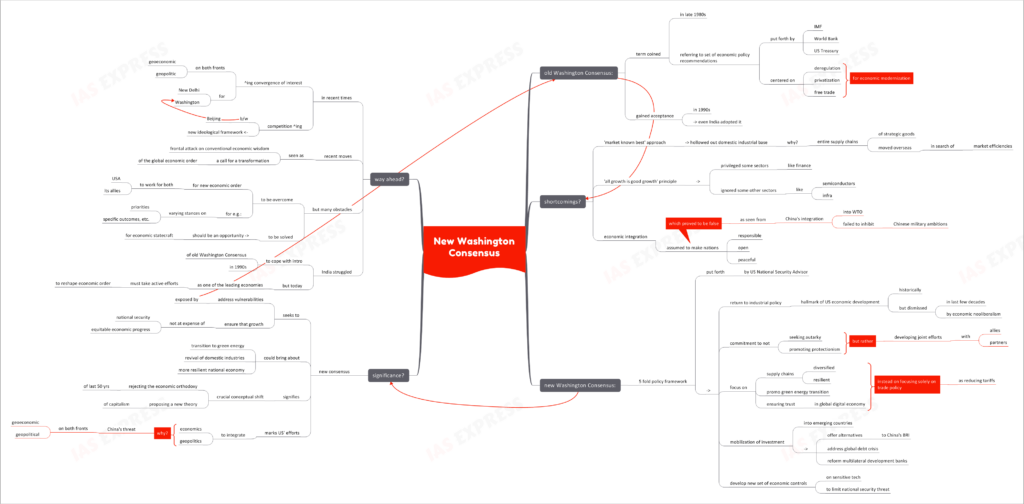The New Washington Consensus- Succeeding the 1990s Washington Consensus

Earlier this month, a set of ideas called the ‘New Washington Consensus’ was put forth by US National Security Adviser Jake Sullivan. This was at a speech at the Brookings Institution. The proposal marks a major policy approach change since the old Washington Consensus of 1990s.

What is the Washington Consensus?
- The Washington Consensus is a term coined in the late 1980s, referring a shared set of economic policy recommendations.
- These recommendations were put forward by the International Monetary Fund, World Bank, and US Treasury.
- The policies were centered on
- Deregulation
- Privatisation
- Free trade as a pathway for economic modernisation.
- The consensus had gained global acceptance by the 1990s, with countries like India also adopting these recommendations.
What are its shortcomings?
Recently, the US National Security Advisor highlighted several challenges that have risen from the old Washington Consensus:
- The ‘markets know best’ approach led to the hollowing out of the domestic industrial base, as entire supply chains of strategic goods moved overseas in pursuit of market efficiency.
- The principle that ‘all growth was good growth’ resulted in the privileging of certain sectors like finance, while some other sectors like semiconductors and infrastructure were failed to flourish.
- The assumption that economic integration would make nations more responsible, open and peaceful proved to be false. For instance, China’s integration into the WTO did not inhibit its military ambitions in its region.
What is the New Washington Consensus?
In a major speech, the US National Security Advisor outlined a set of ideas which he called the ‘New Washington Consensus’. The key highlights of this 5-fold policy framework are:
- A return to industrial policy, which was the hallmark of US economic development historically but dismissed by economic neoliberalism in the past few decades.
- A commitment to not seeking autarky or promoting protectionism, but developing joint efforts with US allies and partners, including India.
- The focus on diversified and resilient supply chains, promoting a clean energy transition, and ensuring trust in the global digital economy. He pointed out that, the current times call for trade policies that are about more than just tariff reduction.
- Mobilisation of investment into emerging economies, offering an alternative to China’s Belt and Road Initiative, addressing the global debt crisis, and reforming multilateral development banks.
- Development of a new set of export controls on sensitive technology to limit national security threats.
Why is it significant?
- The new consensus aims to address the vulnerabilities exposed by the old system and ensure that growth doesn’t come at the expense of national security or equitable economic progress.
- The new consensus has the potential to bring about a transition to clean energy, a revival of domestic industries, and a more resilient national economy.
- The new consensus signifies a crucial conceptual shift, rejecting the economic orthodoxy of the past 50 years and proposing a new theory of capitalism.
- It also marks US’ efforts to integrate economics and geopolitics- two worlds that have tended to remain exclusive from each other till now. This attempt can be attributed to the threat posed by China on both- geopolitical and geoeconomic fronts.
What is the way ahead?
- In both the domains- geopolitical and geoeconomic- there has been growing convergence of interests between Washington and New Delhi. At the same time, the competition between Washington and Beijing has intensified and has now triggered the evolution of a new ideological framework.
- The new initiatives are seen as a frontal attack on conventional economic wisdom and represent a call for a transformation of the global economic order.
- However, to frame a new global economic order that works for both USA and its allies, many obstacles will have to be overcome. For instances, there would be varying stand on priorities, specific outcomes, etc.
- Resolving these problems should be seen as an opportunity, for USA and also for its allies like India, for economic statecraft.
- While India struggled to cope with the introduction of the old Washington Consensus in 1990s, today, India, as one of the leading economies, must take efforts to actively reshape the economic order.
Conclusion:
The Washington Consensus of the 1990s changed the global economic order and established principles like globalization and liberalization. Over the years, its many shortcomings have been realized, alongside its benefits. In the aftermath of the back-to-back economic upheavals in the recent years, USA- the very country that spearheaded the Washington Consensus, seeks to replace it with a new set of economic ideas. India and other developing countries must play an active role in how the new Washington Consensus reshapes the world economy.
Practice Question for Mains:
What is the New Washington Consensus? How would it be different from the 1990s’ version? (250 words)
If you like this post, please share your feedback in the comments section below so that we will upload more posts like this.
![[Web Story] Financial Inclusion in India - Meaning, Objectives, Challenges, Solutions](https://www.iasexpress.net/wp-content/plugins/pt-content-views-pro/public/assets/images/lazy_image.png)
